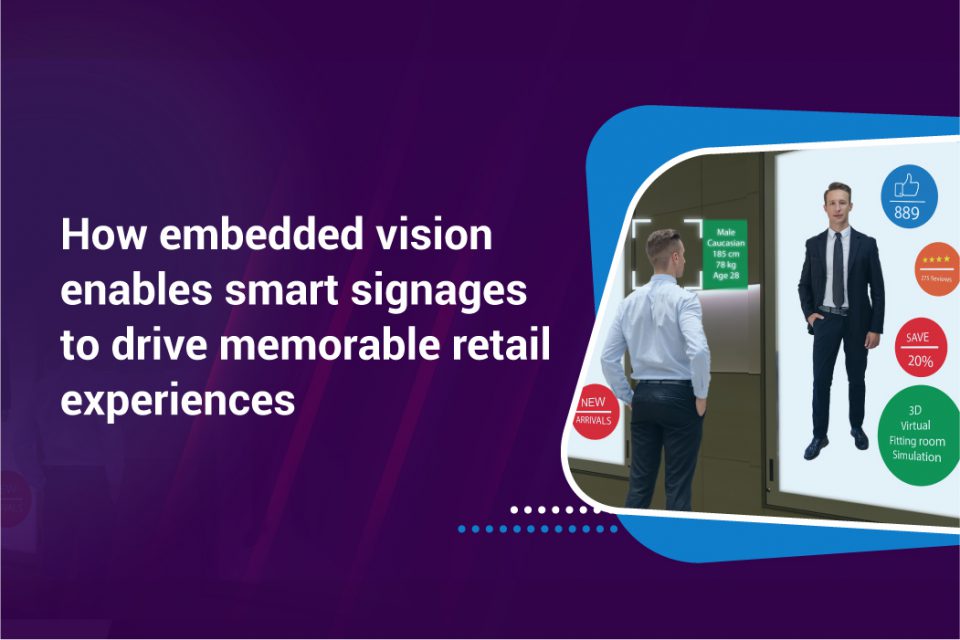Everyone knows that COVID-19 directly impacted retailers – causing production slowdowns and supply chain chaos. But it has also continued to be indirectly responsible for transforming how the retail business works.
How? Simple. Three words – changing customer behavior.
With modern-day retailers finding it challenging to differentiate themselves from the competition, the need for serving personalized customer experiences has increased. Also, beyond providing shelf space and putting up standard displays, retailers have not been able to offer their product suppliers a way to show their products to the right set of potential customers at the right time. Smart signages address both these problems.
In this blog, we look at how embedded vision and cameras empower smart signages to deliver futuristic customer experiences. We will also learn some of the most important features to consider while selecting a camera for smart signages.
Smart signages – Modernizing the retail journey
In this section, let us learn more ways in which smart signages modernize retail stores and elevate customer experience.
The pandemic led to significant changes in the shopping behavior of customers for good. First, they want their interactions to be secure, touchless, and proactive. Essentially, they don’t want to go to retail stores, visit websites, or furiously tap away on mobile apps. Secondly, they want blazing fast experiences instead of browsing through shelves and reading product brochures. Thirdly, they expect personalized content – not just random sales and marketing messages.
Finally, as we enter a transitionary phase of complete modernization, another key customer behavioral change is that they want the best of both worlds (physical and digital). So, they are eyeing phygital shopping as a preferred choice.
With smart signages, a.k.a. digital signages, the modern retailer can do all this and more.
What are smart signages?
In a nutshell, smart signages showcase content that can be customized in real-time to suit the unique needs or wants of customers who are currently in front of them. These state-of-the-art systems are equipped with embedded vision technologies to extract valuable information about customers in order to interpret their behavioral patterns.
Today, smart signages have emerged as a premier analytics solution for leveraging business, operational, and marketing insights. In a retail world where data is the ultimate power, they help in perfecting targeted advertising while measuring its performance in real-time. As the camera captures key details of the customer, the analytics software collects and evaluates real-time audience data like the number of people, age, gender, viewing duration, etc.
So, retailers get access to comprehensive data-rich reports – and can use the information on how customers reacted to personalized brand messages.
How do cameras work in smart signages?
High-performance cameras are either mounted or installed in the smart signage monitors. In most cases, the signage requires a distance coverage of 2-8 feet, which necessitates the mechanical placement of the camera and rotating it suitable to get the full Field of View.
It is also important for the camera lens focus to be set to the hyperfocal length to provide image sharpness at a longer working distance.
Embedded vision challenges of smart signages
Outdoor smart signages are subject to the inherent challenges of being set up in an uncontrolled public location. So, the camera system should be able to accurately track the movement of customers while dealing with multiple faces in the background.
Another problem is making sure smart signages can effectively operate in outdoor environments. Hence, no matter the changing lighting conditions or unpredictable weather patterns, the camera must adapt to such external factors and continue to extract high-quality images.
Five key camera features of world-class smart signages
1) Wide Field of View
There’s a lot of movement in and around smart signages, given their placement in areas with high foot traffic. So, enabling wider FOV provides the capability to recognize people up to a 30-feet distance, and showcase personalized content. Also, cameras in digital signages many a time need to capture full-length images of people standing in front of them. This requires the camera to have a large VFOV (Vertical Field Of View). To achieve this, typically the camera is rotated by 90 degrees, and the captured image is rotated the same amount in the opposite direction to get the final output.
2) Autofocus
The autofocus feature is pertinent as the camera can capture customer-related data at changing distances. This is very helpful since customers may change their positions while viewing the content on the smart signage. However, an autofocus camera might not be required in all smart signages. In cases where the person stands in front of the signage at a fixed distance, a fixed focus camera should do the job.
Autofocus cameras come with two types of lenses – a liquid lens and a VCM (Voice Coil Motor) lens. To know more about the differences between the two types, please visit the article Liquid lens autofocus vs Voice Coil Motor (VCM) autofocus.
3) High Dynamic Range
Adapting to varying lighting conditions is crucial to an outdoor smart signage’s performance. Of course, there’s no telling which part of the day a customer takes notice of the signage or what the weather is likely to be at that moment. But cameras that come with a High Dynamic Range (HDR) offer the ability to capture images in any lighting condition by retaining details of both the brightest as well as the darkest regions of a scene. To learn more about HDR and how HDR cameras work, please have a look at What is High Dynamic Range (HDR)? How do HDR cameras work?
4) High Frame Rate
As earlier mentioned, the cameras used in smart signages have to capture the faces of customers in movement. So, with a high frame rate, the system can eliminate motion blur and prevent interactional breakdowns.
Often motion blur is confused with rolling shutter artifacts. If you wish to learn about the differences between the two, we recommend you go through the article Differences between rolling shutter artifacts and motion blur.
5) Quick AI Integration
Smart signages rely on AI and ML algorithms to execute tasks like facial analysis, biometric verification, and people counting. And it requires the camera system to be easily integrated with AI power to identify customers and offer details on customer emotions and behavior.
Cameras offered by e-con Systems for smart signages
Our UVC-compliant and USB-enabled cameras have all the features that smart signages need to deliver memorable customer experiences for different retail businesses. We are the world’s first manufacturer of USB 3.0 UVC cameras. The smart signage cameras offered by e-con Systems also come with features such as autofocus, small form factor, high dynamic range, wide FOV, high resolution and frame rate, etc.
Recently, e-con Systems helped a US-based leading provider of fuel dispensing equipment solutions to build the perfect interactive smart signage.
Our best-selling cameras for smart signages
- See3CAM_CU22 – Full HD USB 3.1 Gen 1 camera with High Dynamic Range (HDR) and LED flicker mitigation (LFM).
- See3CAM_CU81 – A 4K HDR USB camera based on the AR0821 CMOS color image sensor from onsemi
- See3CAM_130 – A UVC-compliant and AR1335 sensor-based 13MP autofocus USB camera
- See3CAM_160 – 16MP autofocus USB camera based on Sony IMX298
- See3CAM_CU135 – A 13MP fixed focus 4K USB camera based on the AR1335 sensor from onsemi
- e-CAM82_USB – A 4K low light USB camera based on the SONY STARVIS® 1/2.8″ IMX415 CMOS image sensor
- e-CAM83_USB – A 4K HDR USB2 camera based on Sony IMX 317 with dual streaming support
To learn more about e-con’s cameras for smart signages and kiosks, please visit the retail kiosks markets page. To get a view of e-con’s entire portfolio of cameras, please checkout our Camera Selector.
If you are looking for help in integrating world-class cameras into your smart signages, please write to us at camerasolutions@e-consystems.com.

Ranjith is a camera solution architect with over 16 years of experience in embedded product development, electronics design, and product solutioning. In e-con Systems, he has been responsible for building 100+ vision solutions for customers spanning multiple areas within retail including self service kiosks, access control systems, smart checkouts and carts, retail monitoring systems, and much more.


